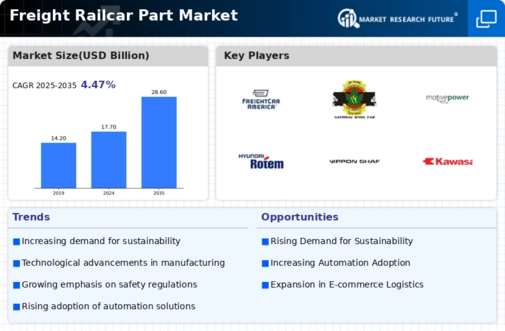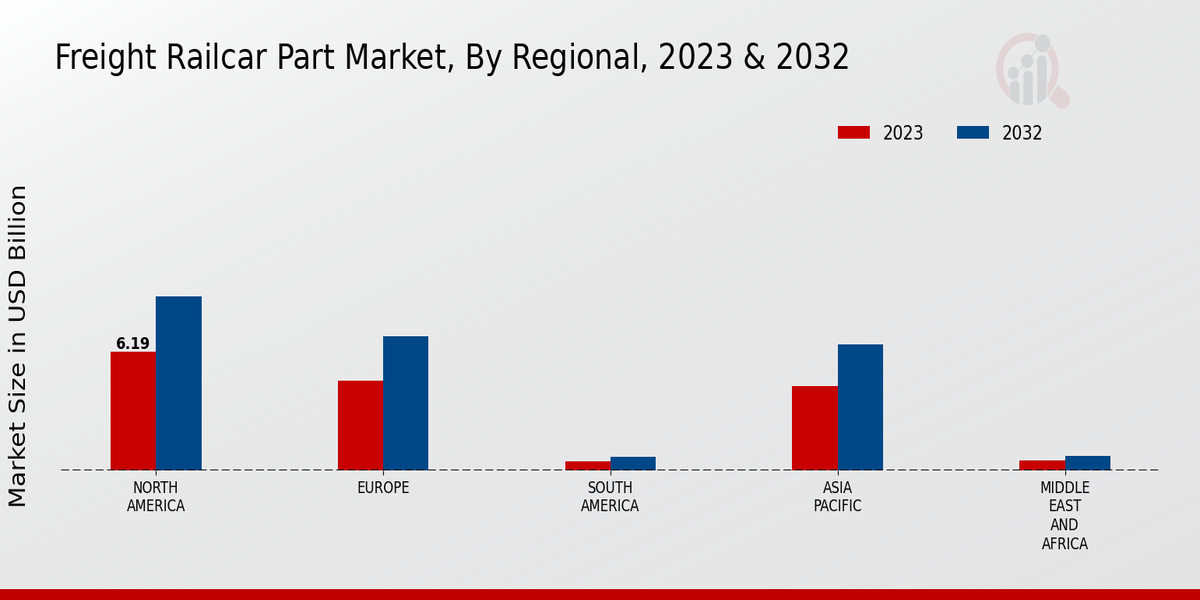Market Growth Projections
The Global Freight Railcar Part Market Industry is poised for substantial growth, with projections indicating a market size of 17.7 USD Billion in 2024 and an anticipated increase to 28.6 USD Billion by 2035. The compound annual growth rate of 4.47% from 2025 to 2035 suggests a robust expansion trajectory. This growth is driven by various factors, including increasing freight demand, technological advancements, and regulatory support for rail infrastructure. The market dynamics reflect a positive outlook, indicating that stakeholders in the freight railcar sector should prepare for a period of significant development and investment.
Growing E-commerce and Retail Sector
The rise of e-commerce is significantly influencing the Global Freight Railcar Part Market Industry. As online shopping continues to expand, the demand for efficient and reliable freight services increases. Rail transport offers a viable solution for moving large volumes of goods across long distances, making it an attractive option for e-commerce companies. The logistics sector is adapting to this demand by investing in rail infrastructure and services. This trend is expected to contribute to the market's growth, with projections indicating a market size of 17.7 USD Billion in 2024. The interplay between e-commerce growth and rail transport efficiency is likely to shape the future of freight logistics.
Regulatory Support for Rail Infrastructure
Government regulations and policies play a crucial role in shaping the Global Freight Railcar Part Market Industry. Many countries are implementing regulations that encourage investment in rail infrastructure, which is essential for enhancing freight capacity. For example, initiatives aimed at reducing carbon emissions are prompting investments in rail systems, as rail transport is generally more energy-efficient than road transport. This regulatory support is likely to stimulate market growth, as it fosters an environment conducive to innovation and expansion within the rail sector. The anticipated compound annual growth rate of 4.47% from 2025 to 2035 underscores the positive impact of these regulations.
Increasing Demand for Freight Transportation
The Global Freight Railcar Part Market Industry is experiencing heightened demand due to the growing need for efficient freight transportation. As global trade expands, rail transport emerges as a cost-effective and environmentally friendly option. In 2024, the market is projected to reach 17.7 USD Billion, reflecting the increasing reliance on rail for moving goods. This trend is further supported by government initiatives promoting rail infrastructure development, which enhances the capacity and efficiency of freight services. The shift towards rail transport is likely to continue, driven by the need for sustainable logistics solutions.
Technological Advancements in Railcar Design
Technological innovations are reshaping the Global Freight Railcar Part Market Industry, leading to enhanced performance and safety features in railcars. Advanced materials and design techniques are being adopted to improve durability and reduce maintenance costs. For instance, the integration of smart technologies enables real-time monitoring of railcar conditions, which can prevent failures and optimize operations. These advancements not only increase the lifespan of railcars but also contribute to the overall efficiency of freight transport. As the industry embraces these technologies, the market is expected to grow significantly, with projections indicating a rise to 28.6 USD Billion by 2035.
Shift Towards Sustainable Logistics Solutions
The Global Freight Railcar Part Market Industry is witnessing a paradigm shift towards sustainable logistics solutions. As environmental concerns gain prominence, businesses are increasingly seeking greener alternatives for transporting goods. Rail transport, known for its lower carbon footprint compared to road transport, is becoming a preferred choice. This shift is not only driven by corporate social responsibility but also by consumer demand for sustainable practices. The market's growth trajectory reflects this trend, with expectations of reaching 28.6 USD Billion by 2035. Companies that adapt to these sustainability trends are likely to gain a competitive edge in the evolving logistics landscape.










